1. Spring
1.1 简介
-
Spring:软件行业的春天。
-
2002年,首次推出了Spring框架的雏形,interface 21框架;
-
Spring框架即以interface21 框架为基础,经过重新设计,并不断丰富其内涵,2004.3.24 发布1.0 版本;
-
Rod Johnson 创始人,是音乐学博士。。。【音符转码?】
-
Spring理念:使现有的技术更加容易使用,本身是一个大杂烩。,整合了现有的技术框架。
-
SSH: Struct2+Spring+Hibernate
-
SSM: SpringMvc + Spring + MyBatis
官网:https://docs.spring.io/spring-framework/docs/current/reference/html/
官方下载地址:http://repo.spring.io/release/org/springframework/spring
GitHub:https://github.com/spring-projects/spring-framework
<!-- https://mvnrepository.com/artifact/org.springframework/spring-webmvc -->
<dependency>
<groupId>org.springframework</groupId>
<artifactId>spring-webmvc</artifactId>
<version>6.0.5</version>
</dependency>
<!-- https://mvnrepository.com/artifact/org.springframework/spring-jdbc -->
<dependency>
<groupId>org.springframework</groupId>
<artifactId>spring-jdbc</artifactId>
<version>6.0.5</version>
</dependency>
1.2 优点
- Spring是一个开源的免费的框架(容器);
- Spring是一个轻量级的、非入侵式的框架;
- 控制反转(IOC),面向切面编程(AOP)
- 支持事务的处理,对框架整合的支持。
Spring就是一个轻量级的控制反转和面向切面编程的框架。
1.3 组成
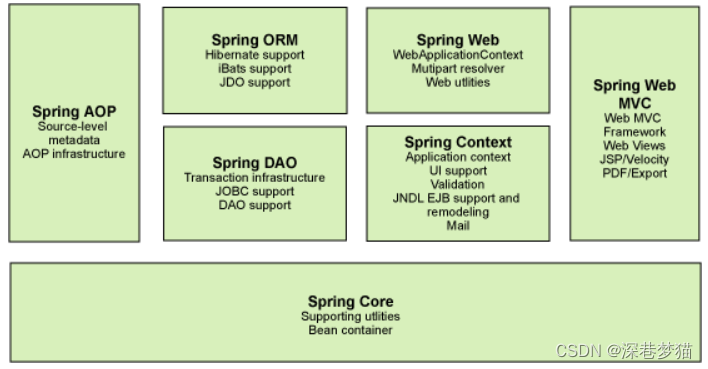
1.4
现代化的Java开发,就是基于Spring的开发。
- Spring boot
- 一个快速开发的脚手架。
- 基于SpringBoot可以快速的开发单个微服务。
- 约定大于配置。
- Spring Cloud
- SpringCloud是基于SpringBoot实现的。
因为现在大多数公司都在使用SpringBoot进行快速开发,学习SpringBoot的前提,需要完全掌握Spring及SpringMVC。承下启下的作用。
弊端:发展了太久之后,违背了原来的理念,配置十分繁琐,人称配置地狱。
2. IOC理论推导
- UserDao 接口
- UserDaoImpl 实现类
- UserService 业务接口
- UserServiceImpl 业务实现类
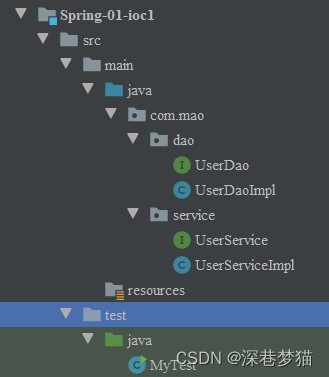
在我们之前的业务中,用户的需求可能会影响我们原来的代码,我们需要根据用户的需求去修改源代码。如果程序代码量十分大,修改一次的成本代价十分昂贵。
我们使用一个set接口实现,已经发生了革命性的变化!
private UserDao userDao;
// 利用set进行动态实现值的注入
public void setUserDao(UserDao userDao) {
this.userDao = userDao;
}
- 之前,程序是主动创建对象,控制权在程序员手上!
- 使用了set注入后,程序不再具有主动权,而是变成了被动的接受对象!
这种思想,从本质上解决了问题,我们程序员不用再去管理对象的创建了。系统的耦合性大大降低,可以更加专注的在业务的实现上。这是IOC的原型。
IOC本质
控制反转(IOC)是一种设计思想,DI(依赖注入)是实现IOC的一种方法。没有IOC的程序中,我们使用面向对象编程,对象的创建与对象间的依赖关系完全硬编码在程序中,对象的创建由程序自己控制,控制反转后将对象的创建转移给第三方,所谓的控制反转就是:获得依赖对象的方式反转了。
采用XML方式配置Bean的时候,Bean的定义信息是和实现分离的,而采用注解的方式可以把两者合为一体,Bean的定义信息直接以注解的形式定义在实现类中,从而达到了零配置的目的。
控制反转是一种通过描述(XML或注解)并通过第三方去生产或获取特定对象的方式。在Spring中实现控制反转的是IOC容器,实现方法是依赖注入(Dependency Injection,DI)。
3. HelloSpring
Bean.xml
<?xml version="1.0" encoding="UTF-8"?>
<beans xmlns="http://www.springframework.org/schema/beans"
xmlns:xsi="http://www.w3.org/2001/XMLSchema-instance"
xsi:schemaLocation="http://www.springframework.org/schema/beans http://www.springframework.org/schema/beans/spring-beans.xsd">
<bean id="mysqlImpl" class="com.mao.dao.UserDaoMysqlImpl"/>
<bean id="oracleImpl" class="com.mao.dao.UserDaoOracleImpl"/>
<bean id="UserServiceImpl" class="com.mao.service.UserServiceImpl">
<!--
ref: 引用Spring容器中创建好的对象
value:具体的值,基本数据类型。
-->
<property name="userDao" ref="oracleImpl"/>
</bean>
</beans>
测试代码
public class MyTest {
public static void main(String[] args) {
// 获取ApplicationContext;
ClassPathXmlApplicationContext context = new ClassPathXmlApplicationContext("beans.xml");
UserServiceImpl userServiceImpl = (UserServiceImpl) context.getBean("UserServiceImpl");
userServiceImpl.getUser();
}
}
修改配置文件达到更改需求的目的。
4. IOC创建对象的方式
- 默认使用无参构造创建对象;
- 假如我们要使用有参构造创建对象;
<!--第一种,下标赋值-->
<bean id="user" class="com.mao.pojo.User">
<constructor-arg index="0" value="laomaoNo1"/>
</bean>
<!--第二种,通过类型创建,不建议使用-->
<bean id="user" class="com.mao.pojo.User">
<constructor-arg type="java.lang.String" value="xiaole"/>
</bean>
<!--第三种,通过参数名-->
<bean id="user" class="com.mao.pojo.User">
<constructor-arg name="name" value="猫"/>
</bean>
总结:在配置文件加载的时候,容器中管理的对象就已经初始化了。
5. Spring配置
5.1 别名 alias
如果添加了别名,我们也可以通过别名获取到这个对象
<alias name="user" alias="userNew"/>
5.2 Bean配置
id : bean的唯一标识符,也就是相当于对象名
class: bean 对象所对应的全限定名: 包名+类型
name : 也是别名,name可以同时取多个别名
<bean id="user" class="com.mao.popjo.UserT" name="u2,u3 u4;u5"/>
5.3 import
一般用于团队开发使用,他可以将多个配置文件,导入合并为一个
假如,现在项目中有多个人开发,这三个人复制不同的类开发,不同的类需要注册在不同的bean中,我们可以利用import将所有人的bean.xml合并为一个总的
- 张三
- 李四
- 王五
- applicationContext.xml
<import resource="beans.xml">
<import resource="beans2.xml">
<import resource="beans3.xml">
使用的时候,直接使用总的配置就可以了。
6. DI依赖注入
6.1 构造器注入
6.2 set方式注入【重点】
- 依赖注入:Set注入
- 依赖:bean对象的创建依赖于容器
- 注入:bean对象中的所有属性,由容器来注入
【环境搭建】
- 复杂类型
package com.mao.pojo;
public class Address {
private String address;
public String getAddress() {
return address;
}
public void setAddress(String address) {
this.address = address;
}
}
- 真实测试对象
public class Student {
private String name;
private Address address;
private String[] books;
private List<String> hobbies;
private Map<String,String> card;
private Set<String> games;
private String wife;
private Properties info;
}
- beans.xml
<?xml version="1.0" encoding="UTF-8"?>
<beans xmlns="http://www.springframework.org/schema/beans"
xmlns:xsi="http://www.w3.org/2001/XMLSchema-instance"
xsi:schemaLocation="http://www.springframework.org/schema/beans http://www.springframework.org/schema/beans/spring-beans.xsd">
<bean id="address" class="com.mao.pojo.Address"/>
<bean id="student" class="com.mao.pojo.Student">
<!--普通值注入,value-->
<property name="name" value="老猫"/>
<!--bean注入,ref-->
<property name="address" ref="address"/>
<!--数组-->
<property name="books">
<array>
<value>红楼梦</value>
<value>西游记</value>
<value>水浒传</value>
<value>三国演义</value>
</array>
</property>
<!--List-->
<property name="hobbies">
<list>
<value>听歌</value>
<value>敲代码</value>
<value>看论文</value>
<value>做实验</value>
</list>
</property>
<!--map-->
<property name="card">
<map>
<entry key="身份证" value="111111111111111111"/>
<entry key="银行卡" value="111111"/>
</map>
</property>
<!--set-->
<property name="games">
<set>
<value>LOL</value>
<value>COC</value>
<value>BOB</value>
</set>
</property>
<!--null-->
<property name="wife">
<null/>
</property>
<!--Property-->
<property name="info">
<props>
<prop key="学号">201702801200</prop>
<prop key="性别">男</prop>
<prop key="姓名">小乐</prop>
</props>
</property>
</bean>
</beans>
- 测试类
public class MyTest {
public static void main(String[] args) {
ClassPathXmlApplicationContext context = new ClassPathXmlApplicationContext("beans.xml");
Student student = (Student) context.getBean("student");
System.out.println(student.toString());
}
}
/*
Student{name='老猫', address=Address{address='null'}, books=[红楼梦, 西游记, 水浒传, 三国演义], hobbies=[听歌, 敲代码, 看论文, 做实验], card={身份证=111111111111111111, 银行卡=111111}, games=[LOL, COC, BOB], wife='null', info={学号=201702801200, 性别=男, 姓名=小乐}}
Process finished with exit code 0
*/
6.3 拓展方式注入
p
xmlns:p="http://www.springframework.org/schema/p"
<!--p命名空间注入,可以直接注入属性的值:property-->
<bean id="user" class="com.mao.pojo.User" p:name="拉毛" p:age="18"/>
测试
@Test
public void test2(){
ClassPathXmlApplicationContext context = new ClassPathXmlApplicationContext("userbeans.xml");
User user = context.getBean("user", User.class);
System.out.println(user);
}
c
xmlns:c="http://www.springframework.org/schema/c"
<!--c命名空间注入,通过构造器注入:construct-->
<bean id="user2" class="com.mao.pojo.User" c:age="18" c:name="漂泊"/>
测试
@Test
public void test2(){
ClassPathXmlApplicationContext context = new ClassPathXmlApplicationContext("userbeans.xml");
User user = context.getBean("user2", User.class);
System.out.println(user);
}
注意点:p和c命名空间不能直接使用,需要导入xml约束。
6.4 Bean的作用域 【Scope】
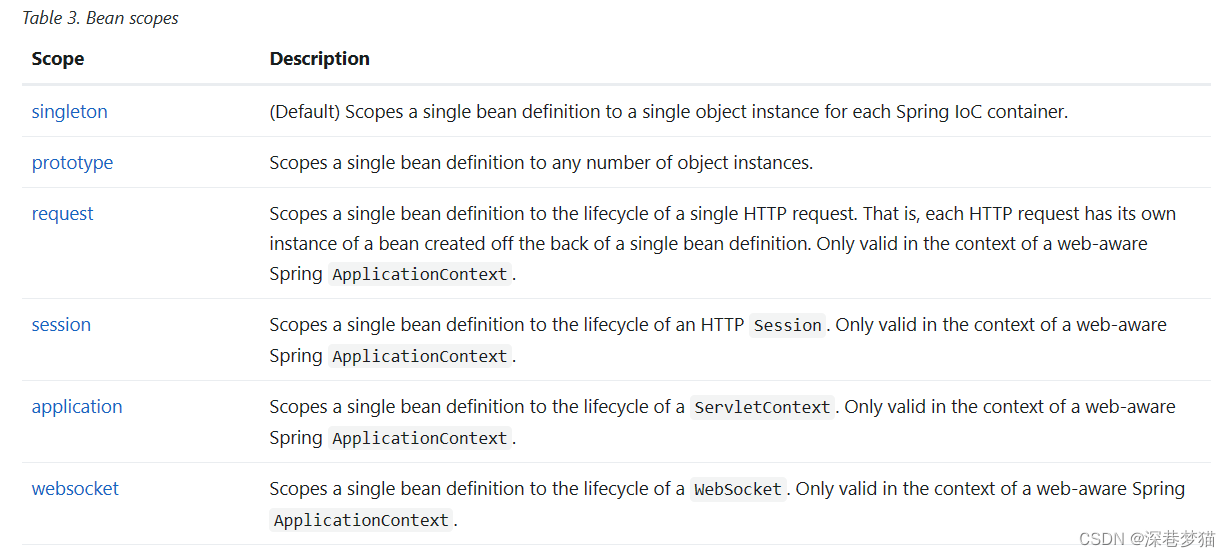
- singleton 单例模式(Spring默认机制)
<bean id="user" class="com.mao.pojo.User" p:name="拉毛" p:age="18" scope="singleton"/>
- prototype 原型模式(每次从容器中get的时候,都会产生一个新对象)
<bean id="user" class="com.mao.pojo.User" p:name="拉毛" p:age="18" scope="prototype"/>
- 其余的request、session、application,这些只能在web开发中使用到。
7. Bean的自动装配
- 自动装配式Spring满足Bean依赖的一种方式;
- Spring会在上下文中自动寻找,并自动给bean装配属性。
在Spring中有三种装配方式:
- 在xml中显示的配置
- 在Java中显示配置
- 隐式的自动配置bean 【重要】
7.1 测试
环境搭建:一个人有两个宠物。
7.2 ByName自动装配
<!--会自动在容器上下文查找,和自己对象set方法后面的值对应的beanid-->
<bean id="people" class="com.mao.pojo.People" autowire="byName">
<property name="name" value="小乐"/>
<!--<property name="cat" ref="cat"/>-->
<!--<property name="dog" ref="dog"/>-->
</bean>
7.3 ByType自动装配
<!--byname:会自动在容器上下文查找,和自己对象set方法后面的值对应的beanid-->
<!--bytype:会自动在容器上下文查找,和自己对象属性类型相同的beanid【要求类型全局唯一】-->
<bean id="people" class="com.mao.pojo.People" autowire="byType">
<property name="name" value="小乐"/>
<!--<property name="cat" ref="cat"/>-->
<!--<property name="dog" ref="dog"/>-->
</bean>
小姐:
- byname的时候,需要保证所有的bean的id唯一,并且这个bean需要和自动注入的属性的方法的值一致;
- bytype的时候,需要保证所有的bean的class唯一,并且这个bean需要和自动注入的属性的类型一致。
7.4 使用注解实现自动装配
jdk1.5 支持的注解,Spring2.5 就支持注解了。
要使用注解须知:
- 导入约束 context
- 配置注解的支持 context:annotation-config/
<?xml version="1.0" encoding="UTF-8"?>
<beans xmlns="http://www.springframework.org/schema/beans"
xmlns:xsi="http://www.w3.org/2001/XMLSchema-instance"
xmlns:context="http://www.springframework.org/schema/context"
xsi:schemaLocation="http://www.springframework.org/schema/beans
https://www.springframework.org/schema/beans/spring-beans.xsd
http://www.springframework.org/schema/context
https://www.springframework.org/schema/context/spring-context.xsd">
<context:annotation-config/>
</beans>
@Autowired
直接在属性上使用即可。也可以在set方式上使用,使用Autowired我们可以不用编写Set方法,前提是这个自动装配的属性在IOC(Spring)容器中存在,且符合名字byname。
科普:
@Nullable 字段标记了这个注解,说明这个字段可以为null;
// 如果显示定义了Autowired的required属性为false,说明这个对象可以为null,否则不允许为空。
@Autowired(required = false)
如果@Autowired自动装配的环境比较复杂,自动装配无法通过一个注解【@Autowired】完成的时候,我们可以使用@Qualified(value=“xxx”)去配置@Autowired的使用,指定一个唯一的bean对象注入。
@Resource
public class People{
@Resource(name = "cat2")
private Cat cat;
@Resource
private Dog dog;
}
小结:
@Resource 和 @Autowired区别
- 都是用来自动装配的,都可以放在属性字段上;
- @Autowired通过byType的方式实现,必须要求这个对象存在;
- @Resource默认通过byname的方式实现,如果找不到名字,则通过bytype实现,两个都找不到,报错。
- 执行顺序不同:@Autowired通过bytype实现,@Resource默认通过byname的方式实现。
8. 使用注解开发
在Spring4之后,要使用注解开发,必须要保证aop的包导入了。
使用注解时需要导入context约束,增加注解的支持。
<?xml version="1.0" encoding="UTF-8"?>
<beans xmlns="http://www.springframework.org/schema/beans"
xmlns:xsi="http://www.w3.org/2001/XMLSchema-instance"
xmlns:context="http://www.springframework.org/schema/context"
xsi:schemaLocation="http://www.springframework.org/schema/beans
http://www.springframework.org/schema/beans/spring-beans.xsd
http://www.springframework.org/schema/context
http://www.springframework.org/schema/context/spring-context.xsd">
<!--指定要扫描的包,这个包下的注解就会生效-->
<context:component-scan base-package="com.mao"/>
<context:annotation-config/>
</beans>
- bean
- 属性如何注入
- 衍生的注解
@Component有几个衍生注解,我们在web开发中,会按照mvc三层架构分层。- dao【@Repository】
- service 【@Service】
- controller 【@Controller】
这四个注解功能都是一样的,都是代表将某个类注册到Spring中,装配Bean
- 自动装配
- 作用域
@Scope(“singleton”) - 小结
xml 与注解:- xml更加万能,适用于任何场合!维护简单方便!
- 注解 不是自己类用不了,维护相对复杂。
最佳实践: - xml用来管理Bean;
- 注解只负责完成属性的注入。
- 在使用过程中,只需要注意一个问题:必须让注解生效,就需要开启注解的支持。
<!--指定要扫描的包,这个包下的注解就会生效-->
<context:component-scan base-package="com.mao"/>
<context:annotation-config/>
9. 使用Java的方式配置Spring
我们现在要完全不使用Spring的xml配置了,全权交给Java来做。
JavaConfig是Spring的一个子项目,在Spring4之后,它成为了一个核心功能。
配置文件
// 这个也会Spring容器托管,注册到容器中,因为它本来就是一个@Componen
// @Configuration代表这是一个配置类,就和我们之前看的bean.xml
@Configuration
@Import(MaoConfig2.class)
public class MaoConfig {
// 注册一个Bean,就相当于我们之前写的一个Bean标签
// 这个方法的名字,就相当于bean标签的id属性
// 这个方法的返回值,就相当于bean标签中的class属性
@Bean
public User getUser(){
return new User();
}
}
实体类
package com.mao.pojo;
public class User {
private String name;
@Override
public String toString() {
return "User{" +
"name='" + name + '\'' +
'}';
}
public String getName() {
return name;
}
public void setName(String name) {
this.name = name;
}
}
测试类
@Test
public void getUser(){
// 如果完全使用了配置类方式去做,我们就只能通过 AnnotationConfig 上下文来获取容器,通过配置类的class对象加载。
AnnotationConfigApplicationContext context = new AnnotationConfigApplicationContext(MaoConfig.class);
User getUser = (User)context.getBean("getUser");
System.out.println(getUser.getName());
}
这种纯Java的配置方式,在SpringBoot中随处可见。
10. 代理模式
为什么学习代理模式?
因为这就是SpringAOP的底层!【SpringAOP 和SpringMVC】
代理模式的分类:
- 静态代理
- 动态代理
10.1 静态代理
角色分析:
- 接口
package com.mao.demo01;
public interface Rent {
public void rent();
}
- 抽象角色:一般会使用接口或者抽象类来解决
package com.mao.demo01;
public class Client {
public static void main(String[] args) {
Host host = new Host();
Proxy proxy = new Proxy(host);
proxy.rent();
}
}
- 真实角色:被代理的角色
package com.mao.demo01;
public class Host implements Rent {
@Override
public void rent() {
System.out.println("房东要出租房子");
}
}
- 代理角色:代理真实角色,一般会做一些附属操作。
package com.mao.demo01;
public class Proxy implements Rent{
private Host host;
public Proxy(){
}
public Proxy(Host host){
this.host = host;
}
@Override
public void rent() {
host.rent();
}
}
代理模式的好处:
- 可以使真实角色的操作更加纯粹,不用去关注一些公共的业务。
- 公共业务就交给代理角色,实现了业务的分工。
- 公共业务发生拓展的时候,方便集中管理。
缺点:
一个真实角色就会产生一个代理角色,代码量会翻倍~开发效率会变低。
10.2 加深理解
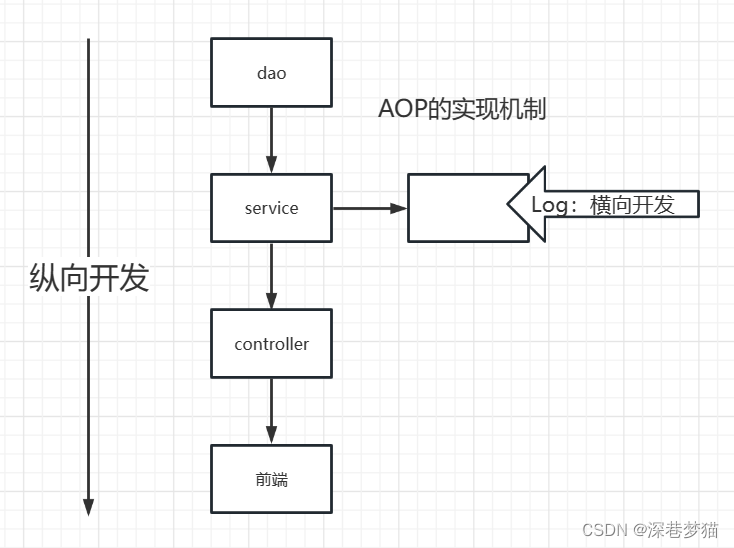
10.3 动态代理
- 动态代理和静态代理角色一样
- 动态代理类是动态生成的,不是我们直接写好的。
- 动态代理分为两大类:基于接口的动态代理,基于类的动态代理。
- 基于接口—jdk动态代理【我们在这里使用】
- 基于类:cglib
- java字节码实现:Javassist
需要了解两个类:Proxy,InvocationHandler:调用处理程序。
动态代理的好处:
- 可以使真实角色的操作更加纯粹,不用去关注一些公共的业务!
- 公共业务就交给代理角色,实现了业务的分工!
- 公共业务发生拓展的时候,方便集中管理!
- 一个动态代理类代理的是一个接口,一般就是对应的一类业务。
11. AOP
11.1 什么是AOP
AOP(Aspect Oriented Programming)面向切面编程,通过预编译方式和运行期动态代理实现程序功能的统一维护的一种技术。AOP是OOP的延续,是软件开发中的一个热点,也是Spring框架中的一个重要内容,是函数式编程的一种衍生范型。利用AOP可以对业务逻辑的各个部分进行隔离,从而使得业务逻辑各部分之间的耦合度降低,提高程序的可重用性,同时提高了开发的效率。
11.2 AOP在Spring中的作用
提供声明式事务;允许用户自定义切面
- 横切关注点:跨越应用程序多个模块的方法和功能。即是:与我们业务逻辑无关的,但是我们需要关注的部分,就是横切关注点。如:日志,安全,缓存,事务等。。
- 切面(ASPECT):横切关注点 被模块化 的特殊对象。即,它是一个类。
- 通知(Advice):切面必须要完成的工作。即:它是类中的一个方法。
- 目标(Target):被通知的对象
- 代理(Proxy):向目标对象应用通知之后创建的对象。
- 切入点(PointCut):切面通知 执行的 地点 的定义。
- 连接点(JointPoint):与切入点匹配的执行点。
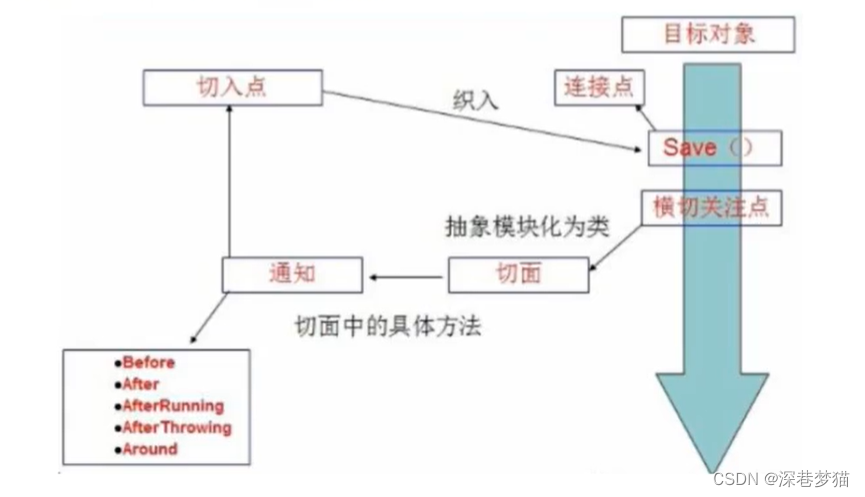
11.3 使用Spring实现AOP
【重点】使用AOP植入,需要导入一个依赖包。
<dependency>
<groupId>org.aspectj</groupId>
<artifactId>aspectjweaver</artifactId>
<version>1.9.19</version>
</dependency>
方式一:使用Spring的API接口
<?xml version="1.0" encoding="UTF-8"?>
<beans xmlns="http://www.springframework.org/schema/beans"
xmlns:xsi="http://www.w3.org/2001/XMLSchema-instance" xmlns:aop="http://www.springframework.org/schema/aop"
xsi:schemaLocation="http://www.springframework.org/schema/beans
http://www.springframework.org/schema/beans/spring-beans.xsd
http://www.springframework.org/schema/aop
https://www.springframework.org/schema/aop/spring-aop.xsd">
<bean id="userService" class="com.mao.service.UserServiceImpl"/>
<bean id="log" class="com.mao.log.Log"/>
<bean id="afterLog" class="com.mao.log.AfterLog"/>
<!--方式一使用原生Spring API接口-->
<!--配置AOP:需要导入AOP的约束-->
<aop:config>
<!--切入点:expression:表达式, execution(要执行的位置! * * * * *)-->
<aop:pointcut id="pointcut" expression="execution(* com.mao.service.UserServiceImpl.*(..))"/>
<!--执行环绕增加!-->
<aop:advisor advice-ref="log" pointcut-ref="pointcut"/>
<aop:advisor advice-ref="afterLog" pointcut-ref="pointcut"/>
</aop:config>
</beans>
测试
import com.mao.service.UserService;
import com.mao.service.UserServiceImpl;
import org.junit.Test;
import org.springframework.context.support.ClassPathXmlApplicationContext;
public class MyTest {
public static void main(String[] args) {
ClassPathXmlApplicationContext context = new ClassPathXmlApplicationContext("applicationContext.xml");
// 动态代理代理的是接口
UserService userService = (UserService) context.getBean("userService");
userService.add();
}
}
方式二:自定义类来实现AOP
<!--方式二: 自定义类-->
<bean id="diy" class="com.mao.diy.DiyPointCut"/>
<aop:config>
<aop:aspect ref="diy">
<aop:pointcut id="point" expression="execution(* com.mao.service.UserServiceImpl.*(..))"/>
<aop:before method="before" pointcut-ref="point"/>
<aop:after method="after" pointcut-ref="point"/>
</aop:aspect>
</aop:config>
方式三:使用注解实现
<!--方式三:通过注解实现-->
<bean id="annotationPointCut" class="com.mao.diy.AnnotationPointCut"/>
<!--开启注解支持! JDK(默认 proxy-target-class="false")cglib(proxy-target-class="true")-->
<aop:aspectj-autoproxy/>
package com.mao.diy;
// 使用注解实现AOP
import org.aspectj.lang.annotation.After;
import org.aspectj.lang.annotation.Around;
import org.aspectj.lang.annotation.Aspect;
import org.aspectj.lang.annotation.Before;
@Aspect // 标注这个类是一个切面
public class AnnotationPointCut {
@Before("execution(* com.mao.service.UserServiceImpl.*(..))")
public void before(){
System.out.println("前");
}
@After("execution(* com.mao.service.UserServiceImpl.*(..))")
public void after(){
System.out.println("后");
}
@Around("execution(* com.mao.service.UserServiceImpl.*(..))")
public void round(){
System.out.println("环绕前");
}
}
12. 整合MyBatis
步骤:
- 导入相关Jar包
- junit
- mybatis
- mysql数据库
- spring相关
- aop植入
- mybatis-spring【new, 专门整合spring和mybatis】
<dependencies>
<dependency>
<groupId>junit</groupId>
<artifactId>junit</artifactId>
<version>4.12</version>
</dependency>
<dependency>
<groupId>mysql</groupId>
<artifactId>mysql-connector-java</artifactId>
<version>5.1.47</version>
</dependency>
<dependency>
<groupId>org.mybatis</groupId>
<artifactId>mybatis</artifactId>
<version>3.5.2</version>
</dependency>
<dependency>
<groupId>org.springframework</groupId>
<artifactId>spring-webmvc</artifactId>
<version>5.1.9.RELEASE</version>
</dependency>
<dependency>
<groupId>org.springframework</groupId>
<artifactId>spring-jdbc</artifactId>
<version>5.1.9.RELEASE</version>
</dependency>
<dependency>
<groupId>org.aspectj</groupId>
<artifactId>aspectjweaver</artifactId>
<version>1.8.13</version>
</dependency>
<dependency>
<groupId>org.mybatis</groupId>
<artifactId>mybatis-spring</artifactId>
<version>2.0.2</version>
</dependency>
<dependency>
<groupId>org.projectlombok</groupId>
<artifactId>lombok</artifactId>
<version>1.18.26</version>
</dependency>
</dependencies>
- 编写配置文件
- 测试
12.1 回忆mybatis
- 编写实体类
- 编写核心配置文件
- 编写接口
- 编写Mapper.xml
- 测试
12.2 MyBatis-Spring
- 编写数据源配置
- sqlSessionFactory
- sqlSessionTemplate
- 需要给接口加实现类
- 将自己写的实现类,注入到Spring中
- 测试
spring.xml
<?xml version="1.0" encoding="UTF-8"?>
<beans xmlns="http://www.springframework.org/schema/beans"
xmlns:xsi="http://www.w3.org/2001/XMLSchema-instance" xmlns:aop="http://www.springframework.org/schema/aop"
xsi:schemaLocation="http://www.springframework.org/schema/beans
http://www.springframework.org/schema/beans/spring-beans.xsd
http://www.springframework.org/schema/aop
https://www.springframework.org/schema/aop/spring-aop.xsd">
<!--DataSource:使用Spring的数据源替换MyBatis的配置 c3p0 dbcp druid
使用Spring提供的JDBC
-->
<bean id="dataSource" class="org.springframework.jdbc.datasource.DriverManagerDataSource">
<property name="driverClassName" value="com.mysql.jdbc.Driver"/>
<property name="url" value="jdbc:mysql://localhost:3306/mybatis?useSSL=true&useUnicode=true&characterEncoding=UTF-8"/>
<property name="username" value="root"/>
<property name="password" value="123456"/>
</bean>
<!--sqlSessionFactory-->
<bean id="sqlSessionFactory" class="org.mybatis.spring.SqlSessionFactoryBean">
<property name="dataSource" ref="dataSource"/>
<!--绑定MyBatis配置文件-->
<property name="configLocation" value="classpath:mybatis-config.xml"/>
<property name="mapperLocations" value="classpath:com/mao/mapper/*.xml"/>
</bean>
<!--SqlSessionTemplate:就是我们使用的sqlSession-->
<bean id="sqlSession" class="org.mybatis.spring.SqlSessionTemplate">
<!--只能使用构造器注入sqlSessionFactory,因为它没有set方法-->
<constructor-arg index="0" ref="sqlSessionFactory"/>
</bean>
</beans>
applicationContext.xml
<?xml version="1.0" encoding="UTF-8"?>
<beans xmlns="http://www.springframework.org/schema/beans"
xmlns:xsi="http://www.w3.org/2001/XMLSchema-instance" xmlns:aop="http://www.springframework.org/schema/aop"
xsi:schemaLocation="http://www.springframework.org/schema/beans
http://www.springframework.org/schema/beans/spring-beans.xsd
http://www.springframework.org/schema/aop
https://www.springframework.org/schema/aop/spring-aop.xsd">
<import resource="spring-dao.xml"/>
<bean id="userMapper" class="com.mao.mapper.UserMapperImpl">
<property name="sqlSession" ref="sqlSession"/>
</bean>
</beans>
13. 声明式事务
1. 回顾事务
- 要么都成功,要么都失败
- 事务在项目开发中,十分的重要,涉及数据的一致性问题!
- 确保完整性和一致性。
事务ACID原则:
- 原子性
- 一致性
- 隔离性
- 多个业务可能操作同一个资源,防止数据损坏
- 持久性
- 事务一旦提交,无论系统发生什么问题,结果都不会再被影响,被持久写入存储器中。
2. Spring中的事务管理
- 声明式事务:AOP
<?xml version="1.0" encoding="UTF-8"?>
<beans xmlns="http://www.springframework.org/schema/beans"
xmlns:xsi="http://www.w3.org/2001/XMLSchema-instance"
xmlns:aop="http://www.springframework.org/schema/aop"
xmlns:tx="http://www.springframework.org/schema/tx"
xsi:schemaLocation="http://www.springframework.org/schema/beans
http://www.springframework.org/schema/beans/spring-beans.xsd
http://www.springframework.org/schema/tx
https://www.springframework.org/schema/tx/spring-tx.xsd
http://www.springframework.org/schema/aop
https://www.springframework.org/schema/aop/spring-aop.xsd">
<!--DataSource:使用Spring的数据源替换MyBatis的配置 c3p0 dbcp druid
使用Spring提供的JDBC
-->
<bean id="dataSource" class="org.springframework.jdbc.datasource.DriverManagerDataSource">
<property name="driverClassName" value="com.mysql.jdbc.Driver"/>
<property name="url" value="jdbc:mysql://localhost:3306/mybatis?useSSL=true&useUnicode=true&characterEncoding=UTF-8"/>
<property name="username" value="root"/>
<property name="password" value="123456"/>
</bean>
<!--sqlSessionFactory-->
<bean id="sqlSessionFactory" class="org.mybatis.spring.SqlSessionFactoryBean">
<property name="dataSource" ref="dataSource"/>
<!--绑定MyBatis配置文件-->
<property name="configLocation" value="classpath:mybatis-config.xml"/>
<property name="mapperLocations" value="classpath:com/mao/mapper/*.xml"/>
</bean>
<!--SqlSessionTemplate:就是我们使用的sqlSession-->
<bean id="sqlSession" class="org.mybatis.spring.SqlSessionTemplate">
<!--只能使用构造器注入sqlSessionFactory,因为它没有set方法-->
<constructor-arg index="0" ref="sqlSessionFactory"/>
</bean>
<!--配置声明式事务-->
<bean id="transactionManager" class="org.springframework.jdbc.datasource.DataSourceTransactionManager">
<constructor-arg ref="dataSource"/>
</bean>
<!--结合AOP实现事务的植入-->
<!--配置事务通知-->
<tx:advice id="txAdvice" transaction-manager="transactionManager">
<!--给哪些方法配置事务-->
<!--配置事务的传播特性:new propagation-->
<tx:attributes>
<tx:method name="*" propagation="REQUIRED"/>
</tx:attributes>
</tx:advice>
<!--配置事务切入-->
<aop:config>
<aop:pointcut id="txPointCut" expression="execution(* com.mao.mapper.*.*(..))"/>
<aop:advisor advice-ref="txAdvice" pointcut-ref="txPointCut"/>
</aop:config>
</beans>
- 编程式事务:需要在代码中,进行事务的管理。






















 226
226











 被折叠的 条评论
为什么被折叠?
被折叠的 条评论
为什么被折叠?








